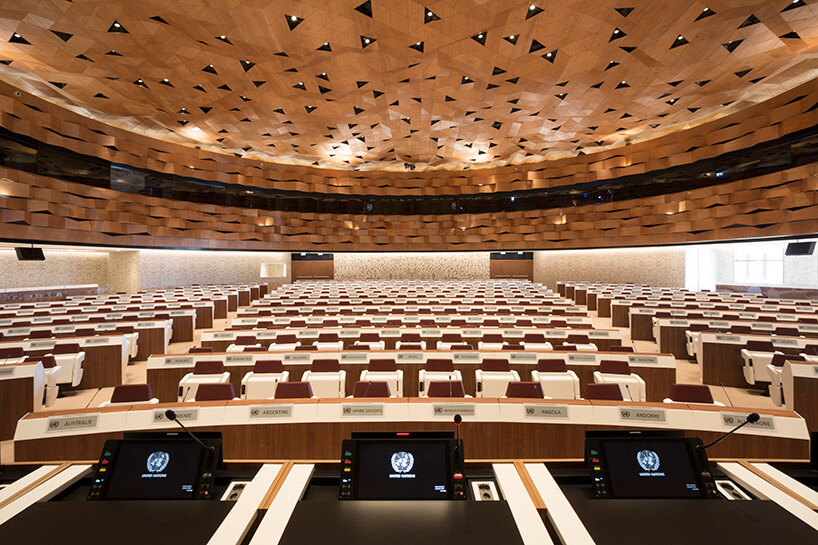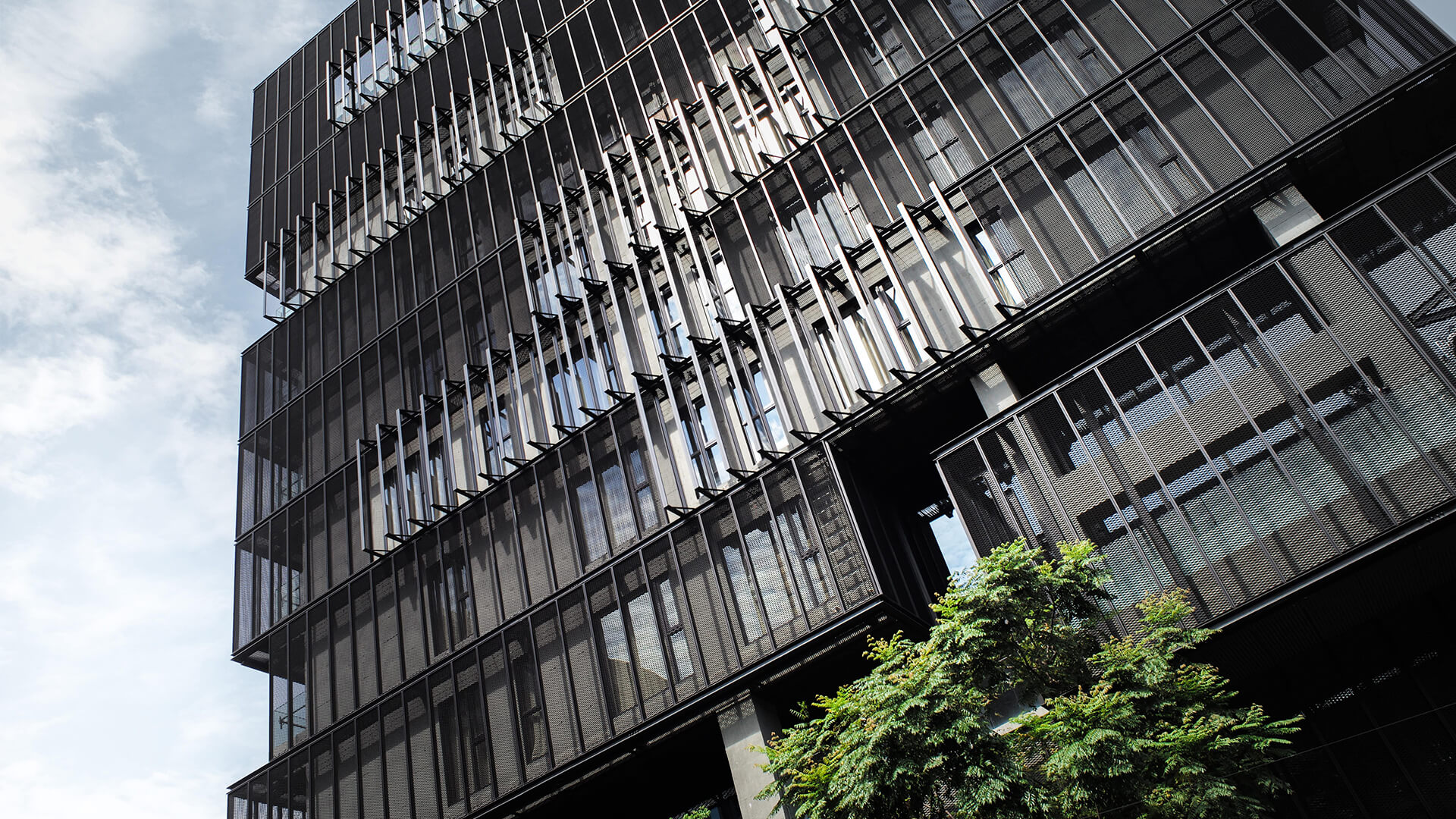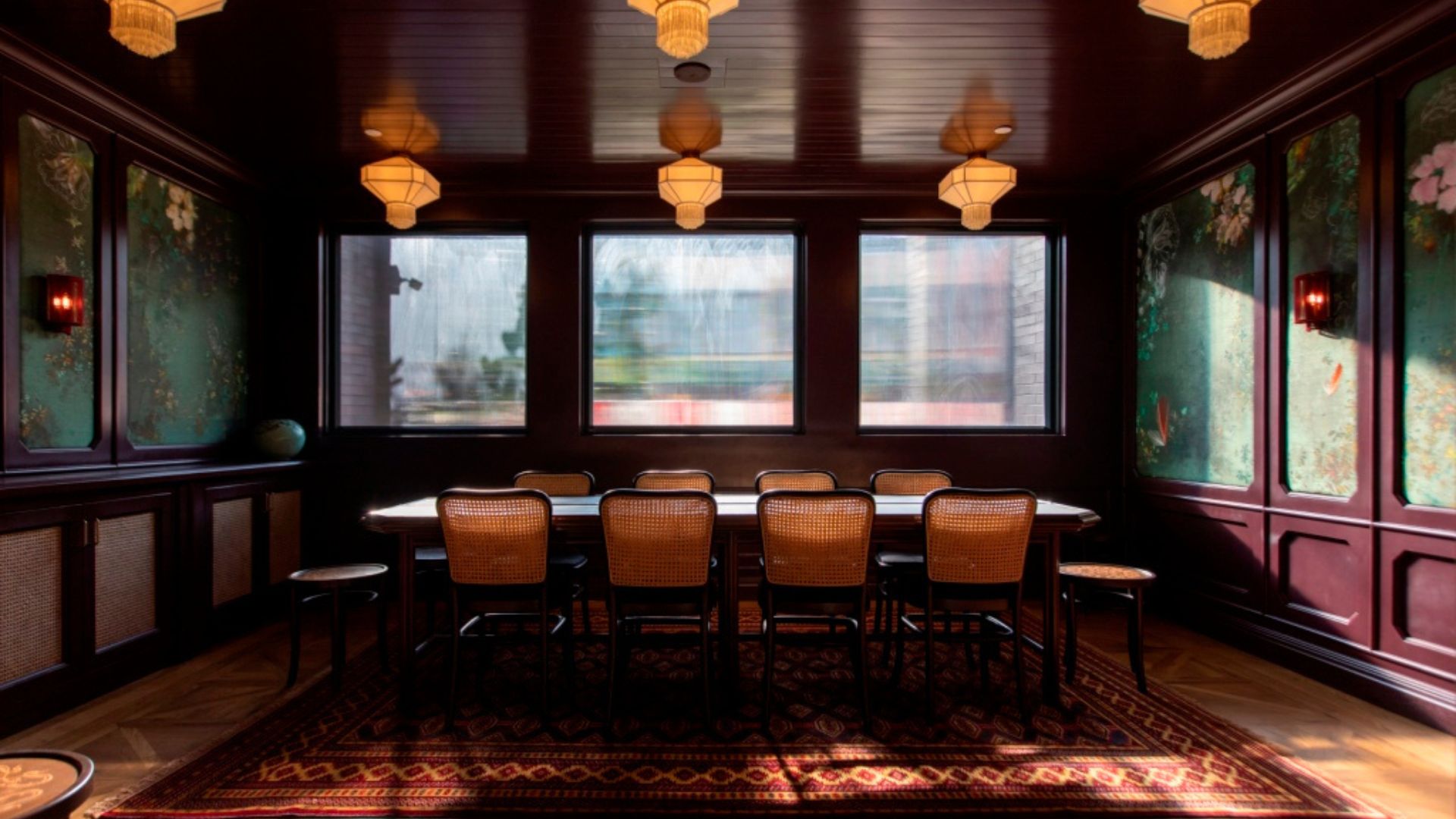The United Nations Room XIX in Geneva gets a wavy digital origami makeover
A sophisticated, flexible, wooden membrane by WOOD-SKIN creates a warm and contemporary upgrade to the Room XIX in the UN Palace, Geneva.

The upgrade of Room XIX now makes it the most sophisticated UN assembly hall in Geneva. It is also the largest hall, at 4000m2 and seating 800. The work was commissioned through a generous donation from the State of Qatar.
The standout feature in the renovation is certainly the distinctive undulating WOOD-SKIN surface used for the ceiling and around the perimeter, which creates a free-form building material from flat sheets, allowing complex structures and shapes, difficult to build with conventional techniques.
The flexible covering of WOOD-SKIN is an internationally patented system.

The minds behind the UN Room XIX – PEIA Associati
The restoration and renovation design of the UN assembly hall was completed by PEIA Associati that selected WOOD-SKIN to create a wavy cover for ceiling and walls.
WOOD-SKIN, the creator of the unique surface covering, is a start-up based in Milan, Italy. It was founded in 2013 by Giulio Masotti, Susanna Todeschini, Gianluca Lopresti, and Stefano Baruffaldi. It is a young team of architects, designers, and engineers led by CEO Giulio Massotti.
Other notable projects which have made great use of WOOD-SKIN include the Lebkov & Sons Café in Amsterdam, and a stunning column custom finished in an artisanal straw marquetry for the Jumeirah Beach Hotel in UAE. The PostOfficeStation Café in Milan features aluminum panels on the facade and also uses WOOD-SKIN extensively inside.
PEIA Associati, also based in Milan, works on large hotel and commercial projects, along with residential and retail spaces. Their projects are situated across the globe from China to Italy to Africa, including 23 projects in Qatar.

Materials & Techniques – A sandwich membrane
The mesh sheets used in the assembly hall are made from okumè, a flame grained timber from West Africa. This creates a very lightweight membrane—less than the original ceiling—so it was not necessary to make any structural reinforcements to the dome.
Each sheet consists of three layers—a high resistance textile mesh core sandwiched between two rigid outer sheets. The rigid sheets are cut into a series of small individual ‘tiles’ which form a continuous surface held together by the mesh layer. Multiple panels are seamlessly connected using wooden flaps on the reverse.
Behind the surface, the skin is supported by guylines which are anchored to the pre-existing structure. These serve an aesthetic as well as structural purpose and software is used to define how they vary in length.
Essential fittings like cameras and the lighting system were carefully laid out in the design process and the WOOD-SKIN surface created to perfectly accommodate them.

Style & Aesthetics – Elegant and fluid folds
With WOOD-SKIN, Peia Associati brought to life the concept of “shifting sand dunes turned upside-down, counterbalanced by the starry sky of the nations below.”
The ceiling of Room XIX is a fluid curved surface created from a continuous field of triangles which bend and fold to create the undulations. The mesh sheets allowed complete freedom to create a unique form, and the surface has a look more akin to paper or fabric than timber.
Around the edge of the circular space, flat wooden panels have been installed in a rhythmic wave pattern. The panels “symbolically represent the mission of the UN to promote and facilitate peace and diplomacy”, and were arranged with the aid of parametric modeling software to achieve acoustic optimization.
The combination of precision and fluidity, plus the warmth of the wood results in a very clean high-end look. The regular geometric pattern gives the ceiling elegance and simplicity.

Sustainability through Treedom
WOOD-SKIN is committed to incorporating sustainable practices in the business, from the use of local materials to minimizing production waste with smart production. They have also committed through a collaboration with Treedom to plant one tree for every 10m2 of WOOD-SKIN produced for each project.
The plants contribute towards offsetting CO2 as well as supporting local communities. WOOD-SKIN currently has a forest of 400 trees planted in Kenya and Cameroon.
Design memento – Digital processes lead innovation
Digital manufacturing is at the heart of the WOOD-SKIN system, and technology leads the way in the design process. As WOOD-SKIN explains: “We believe that real innovations sit at the intersection of composite materials and digital fabrication where technology becomes the enabling factor for new building methods and aesthetics”.
As designing within digital software is now commonplace, complex 3D forms are easy to generate. Yet typically pose a design challenge to actually construct. The WOOD-SKIN system enables designers to more easily bring a digital aesthetic effectively into the real world built environment.

The writer’s comment- A natural progression
Something about WOOD-SKIN feels inevitable and natural. Its look-which sits somewhere between rigid and organic, flowing and folding-is a perfect expression of its underlying digital production, and digital design more generally.
As a membrane that embodies aesthetic, formal and structural dimensions simultaneously, it may also prompt new ways of thinking about building systems. Combined with its acoustic performance which allows for both sound absorption and diffusion, the WOOD-SKIN system offers an elegant solution to realizing complex built forms.
















